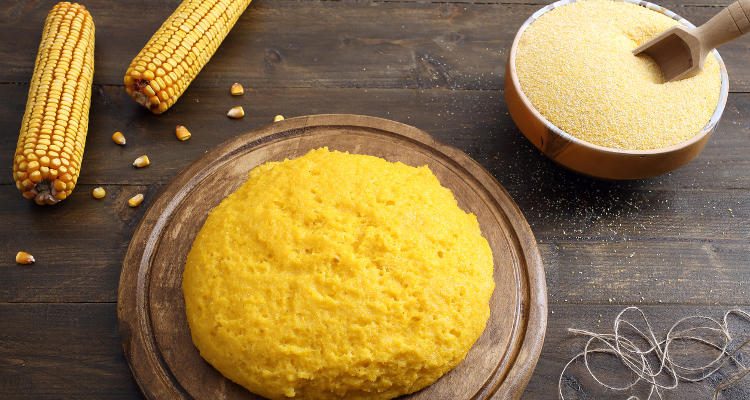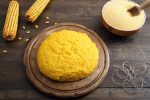
Polenta originated in Northern Italy and was known as the poor people’s staple food as it was made from grains and legumes. The grains and legumes are now substituted for white or yellow ground corn. Polenta is a nutritious food that can be found precooked in stores, or it can be prepared in minutes at home. Polenta nutrition benefits will vary depending on the way it is cooked and the other ingredients used in the recipe.
To reap the maximum nutritional benefits of polenta, you can microwave it or just panfry it. It can also be deep-fried, but that will increase the calories in polenta. It is a gluten-free grain substitute to wheat.
Read on to find out the details of polenta’s nutritional value and if it’s useful for weight loss.
Polenta Nutrition Facts
A serving of 100 grams of polenta has 70 calories. Polenta doesn’t have any fats or cholesterol. It contains a high amount of sodium (about 304 milligrams) and two grams of protein. The total content of carbs in polenta is 15 grams, consisting one gram each of dietary fiber and sugar. It provides 12% of the recommended daily intake of vitamin C, two percent of iron, and six percent of vitamin A.
The store-bought polenta has a higher amount of vitamins A and C in the form of beta-carotene and ascorbic acid, respectively. Other than that, the nutritional value of ready-made polenta is the same as that of homemade polenta. Polenta nutrition facts vary depending on the way it is cooked. A cup of fried polenta has 306 calories, while a cup of baked or cooked polenta has 205 calories.
According to the Journal of Agricultural and Food Chemistry, foods made from milled yellow corn such as polenta, are a natural and excellent source of carotenoids. After researching polenta nutrition, the U.S. Department of Agriculture National Nutrient Database for Standard Reference reports that polenta has traces of vitamins and minerals, and so it cannot be classified as a good source of any of these nutrients. Despite this, polenta is gaining ground as a nutritious food for weight loss.
Is Polenta a Good Carb?
The calories in polenta are mainly from its carbohydrate content. The carbs in polenta make it one of the best high-energy foods, providing sustained energy throughout the day. Polenta has complex carbs which are broken down slowly. This, in turn, helps balance blood sugar levels and sustain the level of energy throughout the day. Polenta can also help you feel fuller, which can lead to consuming less food, and thus, possibly help with weight loss.
Refined carbs found in bread and buns are deprived of fiber. They quickly get digested and enter the bloodstream rapidly, causing a spike in blood sugar. This, in turn, results in an insulin surge and makes you crave more high-carb foods. Refined carbs lack nutrients and are considered empty calories. On the other hand, the complex carbs in polenta help release limited levels of insulin.
High-Protein Polenta Recipes
Although polenta nutrition includes some protein, you can add chicken, pancetta, and peas to your polenta recipe to make it more nutritious and protein-rich. Here are two high-protein polenta recipes for you to try.
Polenta with Peas and Pancetta Recipe
Ingredients:
- 1 tablespoon extra-virgin olive oil
- 2-3 slices thickly cut pancetta, chopped, or 150 grams lardons
- 75 g quick-cooking polenta
- Salt and freshly ground black pepper
- 85 g frozen peas, thawed
- 360 ml chicken stock
- 375 ml milk
- Grated Parmigiano Reggiano cheese
Directions
Heat oil in a saucepan and add pancetta. Cook until crisp, for about five minutes. Transfer the pancetta to a plate and set aside.
Add milk and chicken stock to the pan and bring it to a boil. Whisk in the polenta and stir for two to three minutes, until the mixture thickens.
Season the mixture with salt and pepper and add in the peas. Cook for a minute. Turn off the heat and add cheese. Adjust the seasoning as per taste and serve.
Polenta and Chicken Tartlets Recipe
Ingredients for the tartlets:
- 450 g instant polenta
- 240 ml cream
- 1 teaspoon salt
- ½ teaspoon freshly ground black pepper
Ingredients for the topping:
- 230 g shredded store-bought roasted chicken
- 120 ml store-bought pesto
- ¼ teaspoon salt
- ¼ teaspoon freshly ground black pepper
- 75 g dried cranberries
- 2-inch diameter scalloped cookie cutter
Directions
Make the polenta according to the package instructions. Before it thickens, season with salt, pepper, and cream. Grease a baking sheet and pour the polenta into it. Let it stand for 30 minutes.
To make the topping, combine the chicken, salt, pesto, and pepper in a medium-sized bowl. Stir to combine.
Cut the polenta into tartlet shapes using a two-inch diameter cookie cutter. Top each tartlet with the chicken mixture and a few dried cranberries. The dish is ready to be served.
Polenta nutrition values increase with the addition of proteins. You can increase its nutrition further by adding spices, which will also help boost metabolism. Including ingredients such as cheese and butter will increase the fat and calorie content, so they should be added in moderation.
On the whole, you can make polenta a part of your diet if you want to lose weight, or if you are health-conscious. People with gluten allergies can also consider polenta as a substitute for cream of wheat or wheat bread. You can also use it as a healthy substitute for refined flour when baking.
Related:
- Ginger Turmeric Tea: Nutrition Facts, Health Benefits, and How to Make It
- All About Asparagus: Nutrition Facts, Benefits, & Side Effects
- Strawberry Nutrition Facts and Health Benefits
Sources:
“Polenta Nutrition Facts & Calories,” SELF Nutrition Data web site;
http://nutritiondata.self.com/facts/custom/2898739/2, last accessed February 28, 2017.
Ray, R., “Polenta with peas and pancetta,” Food Network UK web site;
http://www.foodnetwork.co.uk/recipes/polenta-peas-and-pancetta.html, last accessed February 28, 2017.
De Laurentiis, G., “Polenta and Chicken Tartlets,” Food Network UK web site;
http://www.foodnetwork.co.uk/recipes/polenta-and-chicken-tartlets.html, last accessed February 28, 2017.
“Fried Polenta,” FatSecret web site; https://www.fatsecret.com/calories-nutrition/generic/polenta-fried, last accessed February 28, 2017.
“How smart carbs help you lose weight and boost your health and energy,” Catherine Saxelby’s Foodwatch web site, August 27, 2012; http://foodwatch.com.au/blog/carbs-sugars-and-fibres/item/how-smart-carbs-help-you-lose-weight-and-boost-your-health-and-energy.html, last accessed February 28, 2017.
Slayton, R., “Nutrition Information of Polenta,” LIVESTRONG.COM web site, January 13, 2014;
http://www.livestrong.com/article/343497-polenta-nutrition-information/














